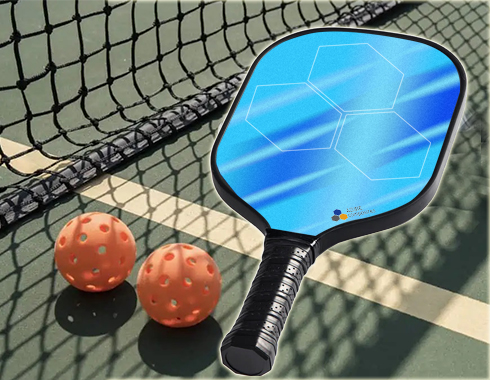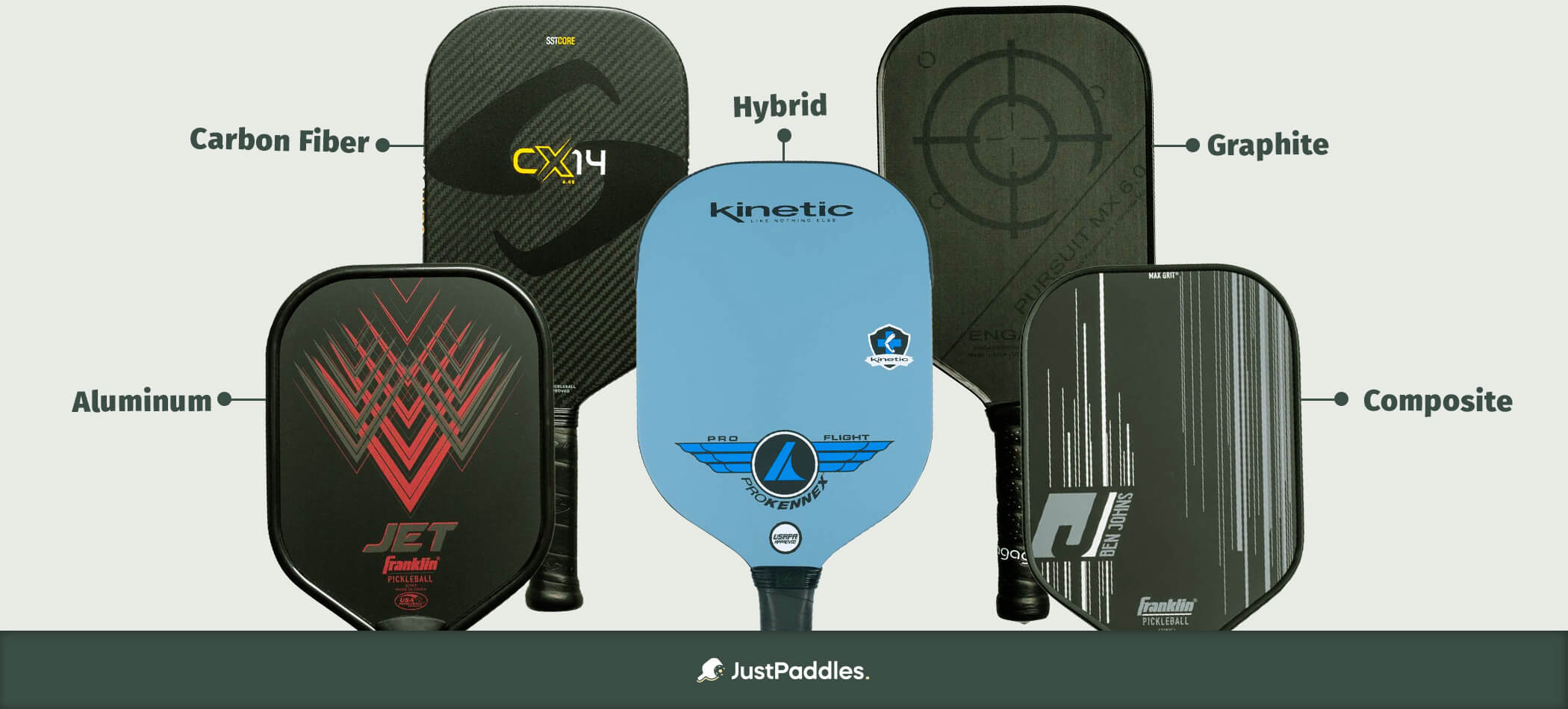Graphite pickleball paddles are known for their reduced weight and greater hit power, making them a popular choice among professional players. On the other hand, composite paddles are preferred by casual pickleball players.
When choosing the best pickleball paddle material, it’s important to consider factors such as weight, paddle core, surface, thickness, and grip size. These elements can greatly impact the playability of the paddle. Whether you’re a competitive player or enjoy pickleball as a recreational activity, selecting the right paddle material can greatly enhance your overall performance and enjoyment on the court.

Credit: azurecomp.com
Understanding The Importance Of Pickleball Paddle Material
Key Factors To Consider For Choosing The Right Pickleball Paddle Material
When it comes to pickleball, the paddle you choose can greatly impact your gameplay and performance. One crucial factor to consider is the material of the paddle. The material not only determines the durability and lifespan of the paddle but also affects its weight, power, control, and overall feel. To make an informed decision, it’s essential to understand the key factors to consider when choosing the right pickleball paddle material.How The Paddle Material Affects Gameplay And Performance
The paddle material plays a significant role in determining how the paddle performs on the court. Different materials have different characteristics, which can affect your shot accuracy, power, and control. Here are some of the popular pickleball paddle materials and how they can affect your gameplay:- Wood: Wood is a traditional material used for pickleball paddles. While it may not offer the same power and control as other materials, it provides a great touch and feel, making it an excellent choice for beginners or players who prefer a softer touch. Wood paddles are also often used for recreational play or in venues that require specific paddle materials.
- Composite: Composite paddles are made from a combination of materials such as fiberglass, carbon fiber, and polymer. These paddles offer a good balance of power, control, and touch. They are known for their durability and ability to absorb vibrations, resulting in a smoother feel during gameplay. Composite paddles are suitable for players of all skill levels.
- Graphite: Graphite paddles are known for their lightweight and high performance. They offer excellent power and control, allowing players to generate more speed and spin on their shots. Graphite paddles are often favored by advanced players who prefer faster-paced gameplay. They are also great for players with arm or shoulder injuries as they reduce strain on the joints.
- Aluminum: Aluminum paddles are known for their durability and longevity. They offer a solid feel and can withstand heavy impacts. However, they may be heavier compared to other materials, which can affect maneuverability and swing speed. Aluminum paddles are commonly used in recreational play or for players who prioritize durability over performance.
Different Types Of Pickleball Paddle Materials
Overview Of Various Paddle Materials Available In The Market
Pickleball paddles are available in a variety of materials, each with its own unique characteristics. Understanding the different paddle materials can help you choose the best one for your playing style and preferences.Comparison Of Pros And Cons Of Each Paddle Material
Wood
Wooden paddles are the traditional choice for pickleball. They are typically made from sturdy hardwood, such as maple, and offer a solid feel and durability. Wood paddles provide good control and are suitable for beginner players. However, they may lack the power and responsiveness of other materials.Graphite
Graphite paddles are a popular choice among competitive players. They are lightweight and offer excellent maneuverability. Graphite paddles provide a great combination of power and control and are favored for their responsiveness. However, they are less durable than other materials and can be more expensive.Composite
Composite paddles are made from a blend of materials such as fiberglass, carbon fiber, and polymer. They offer a balance between power, control, and durability. Composite paddles are known for their versatility and are suitable for players of all levels. They tend to have a larger sweet spot and can provide a softer feel. However, composite paddles may be heavier compared to graphite or wood options.Aluminum
Aluminum paddles are a durable and affordable option. They are lightweight and provide good control. Aluminum paddles have excellent durability and are resistant to dents and dings. However, they may lack the power and responsiveness of other materials, and their rigid construction may increase the risk of injury due to vibration.Polymer
Polymer paddles are known for their durability and affordability. They offer a solid feel and good control. Polymer paddles are suitable for beginner and recreational players. However, they may lack the power and responsiveness of more advanced materials such as graphite or composite.Fiberglass
Fiberglass paddles offer a great combination of power and control. They are lightweight and provide excellent maneuverability. Fiberglass paddles have good durability and can absorb shock, reducing the risk of arm fatigue. However, they may be less responsive compared to graphite options. Overall, the choice of pickleball paddle material depends on your playing style, skill level, and personal preferences. Each material has its own advantages and disadvantages, so consider what aspects are most important to you and try different options to find the paddle that best suits your needs.Wood Pickleball Paddles: Traditional And Reliable
When it comes to choosing a pickleball paddle, there are several factors to consider. One important factor is the material of the paddle itself. While there are many options available, wood paddle material has long been a popular choice among pickleball players. In this article, we will explore the characteristics of wood pickleball paddles and the advantages and disadvantages of using this traditional and reliable material.
Exploring The Characteristics Of Wood Pickleball Paddles
Wood pickleball paddles are known for their traditional look and feel. They are typically made from high-quality wood such as maple or birch, which provides excellent durability and strength. The surface of a wood paddle is typically smooth, offering a comfortable grip and control during gameplay.
One of the main characteristics of wood pickleball paddles is their weight. Wood paddles tend to be on the heavier side compared to other materials such as composite or graphite. This weight can provide players with added power and control, as it allows for more stability and momentum behind each shot.
Additionally, wood pickleball paddles offer a unique sound when the ball makes contact with the surface. This satisfying “thunk” sound is often associated with wood paddles and can add to the overall experience of playing the game.
Advantages And Disadvantages Of Using Wood Paddle Material
Like any other material, wood paddle material has its advantages and disadvantages. Let’s explore them below:
Advantages
- Traditional and reliable: Wood pickleball paddles have been used for decades and have a proven track record of durability and longevity.
- Excellent control: The smooth surface of wood paddles allows for a comfortable grip and precise control over shots.
- Added power: The weight of wood paddles can provide players with extra power and stability, resulting in stronger shots.
- Unique feel and sound: Playing with a wood paddle offers a unique tactile experience and the satisfying “thunk” sound upon ball contact.
Disadvantages
- Heavier weight: The weight of wood paddles may not be suitable for all players, especially those who prefer a lighter paddle for increased maneuverability.
- Less maneuverability: Due to their weight, wood paddles may require more effort to move quickly and react to fast-paced shots.
- Not as versatile: Compared to other materials, wood paddles may not provide the same level of spin and finesse.
- More susceptible to weather: Wood paddles can be affected by changes in humidity and temperature, potentially leading to warping or damage.
Overall, wood pickleball paddles offer a traditional and reliable option for players who prioritize control, power, and a unique playing experience. While they may come with some disadvantages, their durability and classic appeal make them a popular choice among pickleball enthusiasts. Whether you’re a casual player or a seasoned pro, a wood paddle might be worth considering for your next game.
Composite Pickleball Paddles: Versatility And Performance
Understanding The Composition And Benefits Of Composite Pickleball Paddles
Composite pickleball paddles are known for their versatility and performance on the court. These paddles are made from a combination of different materials, resulting in a paddle that offers a balanced blend of power, control, and durability. One of the primary benefits of composite paddles is their ability to absorb shock, which helps reduce strain on the player’s arm and wrist. Composite paddles typically consist of a core material, a face material, and a protective edge guard. The core material is responsible for the paddle’s overall feel and responsiveness. It can be made from materials such as polymer, aluminum, or Nomex, each offering its own unique properties. The face material, usually made from fiberglass or carbon fiber, determines the paddle’s level of power and control. Fiberglass faces provide excellent control and touch, making them ideal for players who prioritize finesse shots and precise ball placement. On the other hand, carbon fiber faces offer more power and pop, making them a great choice for players who rely on aggressive shots and strong hits.Popular Composite Materials And Their Impact On Gameplay
Different composite materials used in pickleball paddle construction have varying effects on gameplay. Let’s take a closer look at some popular composite materials and their impact: 1. Polymer Core: Polymer core paddles are known for their soft and cushioned feel, offering excellent touch and control. They provide a higher level of deflection, making it easier to generate spin. Additionally, polymer cores are quiet and produce less noise upon contact with the ball. 2. Nomex Core: Nomex is a lightweight and sturdy material commonly used in paddle cores. Nomex core paddles offer increased power and responsiveness, making them a popular choice among aggressive players. However, it’s worth noting that Nomex cores can be slightly firmer and may generate more vibration. 3. Fiberglass Face: Paddles with fiberglass faces provide exceptional control and consistency. Fiberglass offers a smooth surface that allows for better ball placement and spin control. These paddles are preferred by players who rely on finesse and accuracy in their gameplay. 4. Carbon Fiber Face: Carbon fiber face paddles are known for their power and durability. The stiffness of carbon fiber allows for enhanced ball speed and a lively response. These paddles are ideal for players who prefer a more aggressive playstyle and prioritize powerful shots. It’s important to remember that the specific combination of core and face material impacts a paddle’s overall performance. Understanding your playing style and preferences will help you choose the ideal composite paddle that suits your needs. In conclusion, composite pickleball paddles offer versatility and performance on the court. With a composition that combines different materials, these paddles strike a balance between power, control, and durability. The choice between polymer, Nomex, fiberglass, or carbon fiber depends on your playing style and preferences. Experimenting with different composite materials will help you find the paddle that enhances your gameplay and takes your skills to the next level.Graphite Pickleball Paddles: Lightweight And Powerful
When it comes to pickleball paddles, choosing the right material can significantly impact your game. One material that stands out for its optimal combination of lightweight construction and power is graphite. Graphite pickleball paddles are extremely popular among players of all skill levels due to their exceptional performance on the court. In this article, we will explore the features and advantages of graphite pickleball paddles, as well as how graphite material enhances control and power in your shots.
Exploring The Features And Advantages Of Graphite Pickleball Paddles
Graphite pickleball paddles are known for their lightweight construction, making them easy to maneuver and highly responsive. The paddles are composed of layers of graphite materials that are tightly bonded together, resulting in a strong and durable paddle that can withstand the demands of intense pickleball gameplay.
One of the key advantages of graphite pickleball paddles is their ability to provide excellent control. The graphite material offers a smooth surface that allows players to have a precise touch on the ball. This level of control is particularly beneficial when it comes to placing shots accurately on the court, allowing players to hit the ball exactly where they want it to go.
In addition, graphite pickleball paddles excel in providing power. The material’s rigidity contributes to a powerful paddle face that can generate a significant amount of force upon contact with the ball. This translates to faster shots and increased shot velocity, giving players an edge in their gameplay.
Furthermore, graphite pickleball paddles offer an optimal balance between control and power. The lightweight nature of the graphite material allows players to generate quick swing speeds, enabling them to react swiftly to shots and execute powerful drives. This versatility makes graphite paddles suitable for players of varying play styles, whether you prefer a finesse-focused game or a more aggressive approach.
Lastly, the durability of graphite pickleball paddles ensures players can rely on their paddle for extended periods. The strong graphite construction ensures that the paddle can withstand regular use and resist wear and tear, making it a worthwhile investment for players looking for a long-lasting paddle.
How Graphite Material Enhances Control And Power In Your Shots
The graphite material used in pickleball paddles has unique properties that contribute to enhanced control and power in your shots. The smooth surface of graphite allows for precise ball placement, giving you the ability to hit the ball exactly where you intend to. This control is crucial when executing shots that require accuracy, such as drop shots or placing the ball close to the sidelines.
Additionally, the rigidity of graphite material provides the necessary power for impactful shots. The stiff paddle face allows for maximum transfer of energy from the paddle to the ball upon contact. This ensures that you can generate powerful shots with greater speed and force, putting your opponents on the defensive and giving you an advantage in rallies.
The lightweight nature of graphite pickleball paddles also contributes to increased power. The reduced weight allows players to swing the paddle faster, resulting in a quicker shot release. This speed, combined with the power generated from the graphite material, enables you to hit fast and explosive shots that are difficult for your opponents to return.
In conclusion, graphite pickleball paddles offer a winning combination of lightweight construction and power. The graphite material enhances control and power in your shots, providing players with the ability to execute precise and powerful shots on the pickleball court. Whether you’re a beginner or a seasoned player, a graphite pickleball paddle can be an excellent choice to elevate your game to the next level.
Frequently Asked Questions On What Is The Best Pickleball Paddle Material
Is Graphite Better Than Composite?
Graphite pickleball paddles offer reduced weight and greater hit power, making them popular among professional and competitive players. On the other hand, composite paddles are preferred by casual players. The main factors to consider when choosing a pickleball paddle are weight, core, surface, thickness, grip size, and handle length.
Is There Really A Difference In Pickleball Paddles?
Yes, there is a difference in pickleball paddles. The weight, paddle core, surface, thickness, grip size, and handle length can all affect playability.
What Is The Difference Between Carbon Fiber And Graphite Pickleball Paddle?
Carbon fiber and graphite pickleball paddles have different characteristics. Graphite paddles are lighter and provide more power, making them preferred by professional and competitive players. Carbon fiber paddles, on the other hand, are favored by casual players for their durability and affordability.
How Do You Pick The Right Pickleball Paddle?
When choosing the right pickleball paddle, consider the material. Graphite paddles are lighter and offer more power, ideal for competitive players. Composite paddles are favorites among casual players. Other factors to consider are weight, paddle core, surface, thickness, grip size, and handle length.
Conclusion
Overall, choosing the best pickleball paddle material depends on your playing style and preferences. Graphite paddles are lighter and provide more power, making them ideal for competitive players. On the other hand, composite paddles are great for casual players due to their durability and versatility.
Consider factors such as weight, core, surface, thickness, grip size, and handle length when selecting your next pickleball paddle. Ultimately, finding the right paddle material can enhance your game and improve your overall playing experience.

